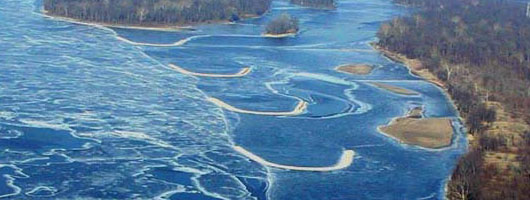
Problems
Narrowing of Channel Widths
Because the lateral or meandering movement of the river has been held in check by these stabilization methods, the river has responded by diverting its lateral energy downward. This causes a deepening of the bendways and a narrowing of the navigation channel. Sandbars in these bends form points, commonly called point bars. These point bars encroach into the navigation channel.
Accidents
When grounding occurs, the safety of the crews aboard the vessel and vessels passing are threatened. The bendway becomes a bottleneck and additional delays in river traffic are incurred. These accidents have occurred historically at bends as far back as the days of the first steamboats. From 1965 to 1988, in the reach of the river from St. Louis to Cairo, IL, there was an average of 20 groundings per year that occurred in the bends. Many of these accidents were a result of the barges running aground on the bars or crashing into the outside riverbanks during flanking maneuvers.
Flanking through Bends
The navigation channel through many of the bends on the Mississippi River becomes so narrow and the current so swift that a barge tow has to use a method of maneuvering called flanking. Flanking involves a series of engine thrusts against the current. The barge tow actually pivots through the bend instead of directly steering. Thus, long periods of time are required to navigate through relatively short stretches of the river. More fuel is required by these towboats because of this flanking.

Traffic Delays and Bottlenecks
Because of the slow flanking required in many of these bends, tows both upstream and downstream have to wait as long as 12 hours before they can navigate through a troublesome bend. The result is long lines of waiting barges called bottlenecks. Considering the number of bends and volume of traffic that exist over the entire length of the waterway, it is obvious that these bottlenecks create massive costs to the towing industry and ultimately to the consumer. In 1988, an investigation was made to assess the cost of time delays due to the bends. Based on the analysis, the cost was estimated to be $24 million.
Dredging of Point Bars
The United States spends millions of dollars each year dredging the point bars at these troublesome bends. The frequency of this dredging depends on the behavior of the river and availability of dredges. However, dredging of these point bars only serves as a short, temporary cure and not as a permanent solution to the problem.

Ice Jams
The formation of ice in the river during the cold, winter months can block the navigation channel in the bends. This is a result of the excessive narrowing of the bend. The downstream flowing ice becomes restricted. Accidents and stoppages in river traffic result. Ice blockages at bends can develop into catastrophic ice dams. When breached, these dams can send massive blocks of floating ice downstream. Anything in the path of the ice, including existing dikes and revetment works can be damaged or destroyed.
Environmental Destruction
Excessive overbank scour is a phenomenon that is caused by river conditions in some bends. Erosion of the overbank areas can destroy adjacent farmland and wetlands. In some areas, dikes were constructed on the sandbar side of the bendway. This was done in an attempt to improve the navigation channel. These "bar" dikes were used by predators, all-terrain vehicles and humans to gain easy access to the sandbars from the main bankline.
Side Channels
Side channels are a critical biological component of the Mississippi River. Most side channels within the MMR lack bathymetric diversity and tend to be somewhat homogenous, containing relatively few scour holes and flat, high elevation channel inverts. There is a critical need to rehabilitate and conserve these critical aquatic habitats. The purpose of this plan is to address the environmental health of the side channels of the Middle Mississippi River and to assure the continued accrual of benefits they provide to the system.






